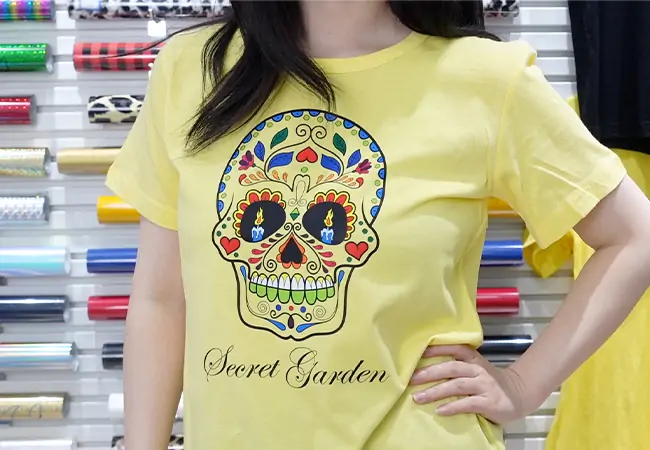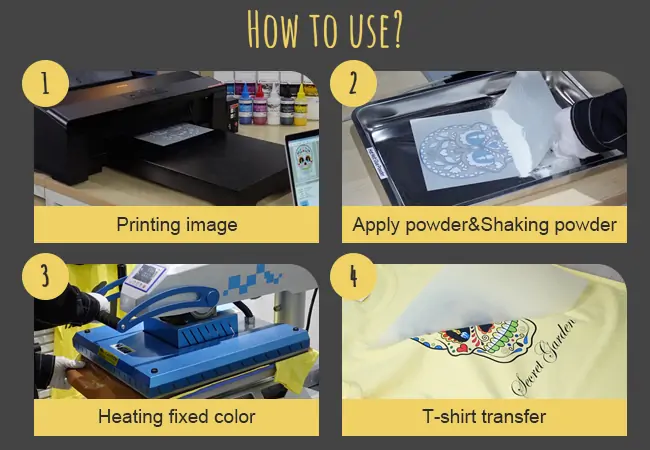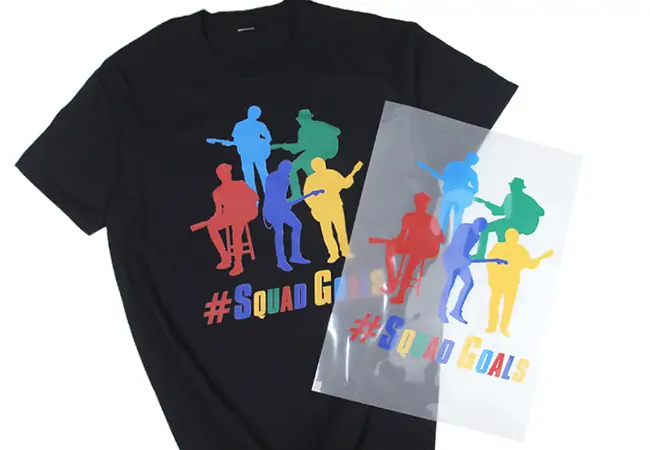What is DTF Transfer?

As a new technology, dtf printing is becoming more and more popular in the global market, and the attention is also getting higher and higher. But, for what Is DTF Transfer? Maybe there are still some friends are not very clear on it, so taking this opportunity today, VISION,as a professional DTF printing factory, talk about this special printing and to tell you what DTF Transfer is.
What Is DTF Transfer, the base consumables we need?
1. Six-color inkjet printer (A4/L805 and A3/L1800 desktop printers, it should be noted that the machine must be artificially modified and used with RIP software)
2. Five colors of paint ink, C, M, Y, K, W (the ratio of color ink and white ink consumption is 45:100)
3. DTF film sheets and rolls ( thickness 7.5 microns, size A4 & A3, 0.30m*100m & 0.60m*100m )
4. Shaking heat press machine or oven (the distance between the direct pressure heating plate and the bottom plate is too high, the heating is uneven, and it is not easy to be heated; the oven is recommended to use an industrial oven, and the details are to be verified)
5. DTF powder,also called Hot melt adhesive powder (particle size 80-170 microns)
6.Tray (it is recommended to use plastic trays, iron and stainless steel trays may have static electricity, resulting in uncertain situations later)
The operation process of DTF Transfer:
1. Use a dtf printer equipped with pigment textile ink to print the pattern on the DTF film sheets and rolls;
2. Sprinkle the hot melt adhesive powder to the DTF film sheets which with patterns on it immediately after the printing is completed (to prevent the pattern ink from drying and the hot melt adhesive powder cannot stick to the pattern), shake off the hot melt adhesive powder outside the pattern to prevent excess Hot melt adhesive powder remains on the DTF film sheets;
3. Set the temperature of the heat press machine to 180°C, place the printed DTF film sheets in the middle of the backing plate, bake for 40-50S, and then melt the glue powder and spread it on the pattern.
4. The temperature of the heat press machine is set to 180?, the time is 8-10S, then put the DTF film sheets with pattern on the heat press machine, pressed down, to finish the transferring on the fabric.
Matters needing attention about DTF Transfer:
1. The printing software used by the printer is required for printing (there will be a video explanation for the software operation). After the software has imported the picture, you need to pay attention to the typesetting: the pattern should not be too close to the top and left and right edges of the printing DTF film sheets, and the tail edge should be kept about 3-4CM After printing a piece of DTF film sheets, you need to take the DTF film sheets to the paper tray. After printing, the ink is wet. If you don’t remove it, the pattern on the second DTF film sheets will be scratched off.
2. The format of the printed picture must be in PNG format with transparent bottom. Pay attention when designing the picture; the transferred picture can be hollowed out. It is recommended that the hollowed-out pattern should not be dense small lines. Part of the rubber powder is difficult to shake completely clean, destroying the effect of the transfer.
3. When dusting, let the printing DTF film sheets pass through the middle of the dtf transfer powder, so that the adhesive powder is evenly sprinkled on the pattern. After dusting, the adhesive DTF film sheets needs to be shaken. Do not touch the adhesive powder directly with your hands. Flick, shake off the glue powder on the edge of the pattern.
4. When putting the DTF film sheets into the printer, it is recommended to wear plastic gloves to prevent the sweat on your hands from sticking to the coating, resulting in the white ink not covering the pattern evenly.
In addition, the coating of the printing dtf transfer film sheets is very thin. It is necessary to pay attention to prevent damage to the coating when taking the DTF film sheets, resulting in the coating not absorbing ink.
5. It is recommended to wear gloves when shaking powder to prevent sweat from sticking to the DTF film sheets. If there is sweat on the DTF transfer film sheets, it will cause the powder to stick to the DTF film sheets, and it will melt on the DTF film sheets when baking. When printing, it will be transferred to the fabric at the same time, destroying the effect of the transfer.
6. There are two ways to bake hot melt adhesive powder:
(1) Bake the heat press machine, set the temperature of the heat press machine (here you need to use the shaking head heat press machine) to 180°C, place the pattern in the middle of the bottom half of the heat press machine, just below the heating plate, bake for 40 -50S, that is, the hot melt adhesive powder can be melted.
(2) Bake in the oven, set the oven temperature to 100°C, heat up and down, preheat the oven for 2-3 minutes, then place a piece of paper or a thin template on the tray of the oven, and place the printed pattern on the DTF film sheets. On the paper, put it in the oven and bake for 40-60s, pay attention to observe the glue powder melt;
When baking, it is recommended to use an oven for A3 size or large-format patterns. When baking with a heat press machine, part of the glue powder has completely melted, and part of the glue powder has not yet begun to melt. This state is very stable after transfer. degree will have an impact;
The baking time should not be too short. If the time is too short, the glue powder will not be completely melted, and the pattern will be granular.
In addition, the difference between the oven and the heat press machine: the oven is closed, the internal temperature is relatively balanced, and the glue powder melts more evenly when baking; the heat press machine is open, the temperature will be unbalanced, and the heat will be lost. Therefore, the melting of the glue powder will be uneven when baking.
7. When transferring, set the heat transfer machine to 180°C, 8-10S, and medium pressure.
8. The DTF film sheets by VISION dtf printing manufacturer can be peeled warmly, coldly or hotly.
9. Washing the fabrics after 24 hours, turn the clothes over to wash, do not bleach, dry, do not soak for a long time, can be hand washed or machine washed.






